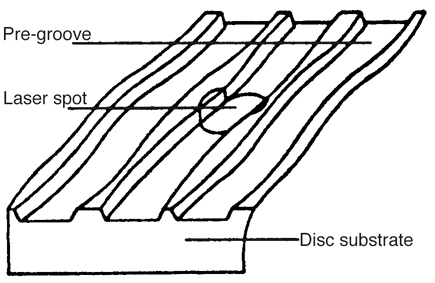
Much has been written about digital data compression or (if that term offends the audio purist) bit-rate reduction. It has been said that digital data compression is the wave of the future, as far as audio and video are concerned. Indeed, the almost simultaneous introduction of DCC (Philips' Digital Compact Cassette) and the MiniDisc (by Sony) confirm that premise, since both use proprietary forms of data compression known, respectively, as PASC and ATRAC. There is, however, a great deal more innovative technology involved in both of these formats beyond data compression.
Having recently gone on a press trip to Sony's facility in Japan, I now know much about the mechanical and physical aspects of the MiniDisc format and about its specific method of data compression. It is these mechanical and physical characteristics of the MiniDisc that I will address in this discussion.
The MiniDisc has been positioned as a record/playback format especially suited for portable applications, Walkman-type miniature players and mobile or car audio systems. The biggest problem using optical discs, such as CDs, in portable applications has been skipping or mistracking caused by shock or vibration. This difficulty has been virtually eliminated in the MiniDisc system thanks to the use of a memory chip. The memory acts as a buffer, holding digital data equivalent to approximately 10 seconds of playing time before passing the data on for conversion into analog signals for playback. If the player's pickup is jarred from its position on the disc, the semiconductor memory will continue to supply data to maintain uninterrupted playback. Because the position of the laser pickup is constantly monitored, using address locations that are present in both recordable and prerecorded MiniDiscs, the laser is able to quickly resume its correct position.
To fill the buffer memory, the MiniDisc player must read data from the disc at a faster rate than the decoder uses that data. In practice, this is a reading rate of 1.4 megabits per second, nearly five times the rate of playback. Since data read into the buffer when it's full would be lost the system only reads data at intervals during normal play. Though the data reaches the buffer in bursts, it's clocked out of the buffer in a steady stream, so playback is not affected. If a shock interrupts the position of the optical pickup reading the MiniDisc, however, the amount of data read in subsequent intervals is increased to make up for the data lost while the pickup was incorrectly positioned. Once the buffer memory's contents are replenished, the pickup resumes reading the signals at regular intervals.
Types of MiniDisc
Two types of discs have been developed for the MiniDisc system. Designed specifically for prerecorded music from record companies, playback-only MiniDiscs are similar to CDs in many ways. The lead-in area is on the inner circumference of the disc. This is followed by the program area, while the lead-out area is on the outer circumference of the disc. Information is recorded as pits in the disc's substrate in much the same way as with full-size CDs. The discs can be stamped out and mass-produced with an injection molding machine. The entire front of the caddy that protects and holds the prerecorded disc can be used for graphics, since the protective shutter on this caddy opens only on the back side.
One of the most important features of the MiniDisc is complete random access capability. That's not surprising on playback-only MiniDiscs; they are recorded like CDs-complete with digital addresses for each selection or track-for quick and easy access to any point on the disc. On the other hand, random access is harder to achieve on a disc whose final recorded sequence is unknown at the time of manufacture and, indeed, can be changed many times. Thus, the recordable discs must be pre-grooved, for tracking and spindle-servo control in recording and playback. Sony's technique was to give these pregrooves a wobble, a slight shift in groove position that creates subtle address marks at 13.3-millisecond intervals (Fig.1).
 |
| Fig. 1 The pre-grooves molded into recordable MiniDiscs for tracking control have a wobble. |
Sony has devoted part of the recordable disc's inner circumference to a user table of contents (UTOC) area whose data structure is more like that of a computer floppy disk than a normal CD. This allows the track numbers and addresses to be edited in seconds (far more quickly than in systems like DAT, where the track numbers are written at the points where each selection actually begins). It also speeds and simplifies automatic renumbering. For example, if you edit out track 3, tracks 4 and 5 will be renumbered 3 and 4; if you combine tracks 4 and 5, track 6 will then be designated track 5.
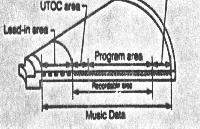 |
| Fig. 2 Cross section of a recordable MiniDisc. |
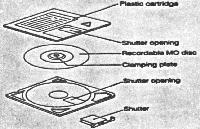 |
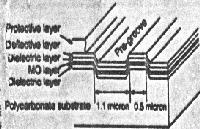 |
| Fig. 3 | Fig. 4 |
| Exploded view of a recordable MiniDisc and caddy; note that the sliding shutter uncovers windows on both sides of the disc. | Layered construction of the recordable MiniDisc. |
Principles of MO Recording
Magneto-optical discs can be rerecorded countless times. As the name implies, the recording system uses both optical and magnetic technology. The recordable layer in an MO disc is made of a magnetic material. A laser beam heats a tiny area of the recordable layer to its Curie temperature (typically, about 400 degrees F), which demagnetizes it. If a magnetic field is applied to that spot as it begins to cool, the spot will acquire a north or a south magnetic polarity, corresponding to a digital zero or one.
On conventional MO discs used for computer data storage, all previously recorded signals must be erased before new data can be recorded. Previous systems have used one of two methods to accomplish this: Either two lasers are used, one for erasing and one for recording (much like a tape recorder with separate erase and recording heads), or a single laser is used with old data erased in the first rotation and new data recorded during a second rotation.
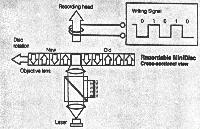 |
| Fig. 5 Magnetic Field Modulation overwrite system. |
Unlike these conventional approaches, the MiniDisc Magnetic Field
Modulation overwrite system writes new signals over old ones. This
system uses a magnetic head on one side of the disc and a laser beam
on the other side in the same corresponding position (Fig. 5). With
the disc situated between the magnetic head and the laser, the laser
brings the spot beneath it up to the Curie point, which dissipates its
previous magnetic orientation. As this spot on the disc moves away
from the laser, it cools to a temperature below the Curie point and a
new magnetic orientation corresponding to the input signal is created
by the magnetic head.
The Dual-Function Optical Pickup
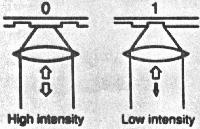 |
| Fig. 6 In prerecorded MiniDiscs, as in CDs, digital signals are represented by pits and lands that cause variations in reflected light intensity. |
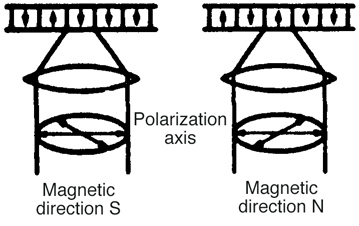 |
| Fig. 7 In recordable MiniDisc digital signals are represented by magnetic poles that rotate the polarization of the reflected laser beam. |
Recordable discs are different. The data is represented by difference in the polarization of the reflected light not by difference in its intensity. A phenomenon known as the Kerr effect rotates the plane of polarization slightly forward or back, depending on the polarity of the magneto-optical recorded signal (Fig. 7). A polarizing beam splitter varies the distribution ratio of the reflected light according to the direction of polarization: A photodetector on one side of the beam splitter will receive a larger share of light reflected in the forward direction, while a detector on another side receives a larger share of light polarized the opposite way. The differences between the electrical outputs of the two photodiodes are used to re-create the binary zeros and ones. The fact that light reflected from the disc changes its polarity according to magnetic orientation is fundamental to the MiniDisc's recording system.
Sony recognizes that success in marketing the new format will require the simultaneous release of MiniDisc software by record companies along with the introduction of MiniDisc hardware. Like CDs, playback-only MiniDiscs carry subcode data, which simplifies production from master tapes made for CD. (The MiniDisc does, however, have additional subcode sectors that can be used for such information as lyrics or explanatory text.) MiniDisc also uses the same basic pressing system as CD. Therefore, a significant advantage of the MiniDisc is that CD mastering systems now in use, including 3/4-inch U-Matic cassette media used for mastering, can also be used in MiniDisc production.
From what I was able to observe during my short visit, Sony has explored all aspects of this new technology (work began on the MiniDisc concept back in 1986). At Sendai, about 180 miles north of Tokyo, there was even a production line turning out blank recordable MiniDiscs, with much of the production line already fully automated.
How successful the MiniDisc format will be remains to be determined. It is to Sony's credit that they are not claiming "CD-quality sound" for this new product. Rather, they are saying that under conditions in which MiniDisc is likely to be used, listeners will be hard-pressed to tell the difference between CD sound and MiniDisc sound.
Many of us attending the technical sessions at Sony headquarters brought along some of our favorite CDs for auditioning. The digital output from a CD player was alternately heard after normal D/A conversion and after being passed through a MiniDisc format A/D converter (which compressed the digital data as it would be compressed in a MiniDisc) and D/A converter. For some of the music, most of us could not detect significant differences in sound quality. With other recordings, most of us could detect a difference, but not a difference that could be said to have seriously degraded the musical quality.
All of us attending the sessions were, I believe, impressed with the sophisticated technology involved in the creation of this new optical disc format. I'll have to reserve judgement about MiniDisc's ultimate sound quality for a later date, when I get my hands on a MiniDisc recorder/player for more definitive listening tests.